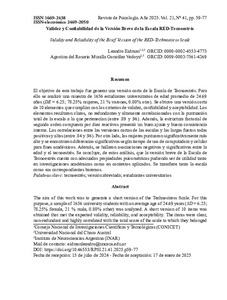Por favor, use este identificador para citar o enlazar este ítem:
https://repositorio.uca.edu.ar/handle/123456789/19995| Título: | Validez y confiabilidad de la versión breve del la escala RED-tecnoestrés Validity and Reliability of the Brief Version of the RED-Technostress Scale |
Autor: | Eidman, Leandro Munilla González Vedoya, Agostina del Rosario |
Palabras clave: | ESTRES; TECNOLOGIA; ESTUDIANTES UNIVERSITARIOS | Fecha de publicación: | 2025 | Editorial: | Pontificia Universidad Católica Argentina. Facultad de Psicología y Psicopedagogía | Resumen: | El objetivo de este trabajo fue generar una versión corta de la Escala de Tecnoestrés. Para ello se analizó una muestra de 1656 estudiantes universitarios de edad promedio de 24.69 años (DE = 6.25; 78.25% mujeres, 21 % varones, 0.80% otro). Se obtuvo una versión corta de 10 elementos que cumplían con los criterios de validez, confiabilidad y aceptabilidad. Los elementos resultaron claros, no redundantes y altamente correlacionados con la puntuación total de la escala a la que pertenecían (entre .89 y .96). Además, la estructura factorial de segundo orden compuesta por diez reactivos presentó un buen ajuste y buena consistencia interna. Las correlaciones entre las versiones cortas de las escalas y las largas fueron todas positivas y altas (entre .84 y .96). Por otro lado, las mujeres puntuaron significativamente más alto y se encontraron diferencias significativas según tiempo de uso de computadora y celular para fines académicos. Además, se hallaron asociaciones negativas y significativas entre la edad y el tecnoestrés. Se concluye, de estos análisis, que la versión breve de la Escala de Tecnoestrés cuenta con adecuadas propiedades psicométricas pudiendo ser de utilidad tanto en investigaciones académicas como en contextos aplicados. Se transfiere tanto la escala como sus correspondientes baremos. The aim of this work was to generate a short version of the Technostress Scale. For this purpose, a sample of 1656 university students with an average age of 24.69 years (SD = 6.25; 78.25% female, 21 % male, 0.80% other) was analyzed. A short version of 10 items was obtained that met the expected validity, reliability, and acceptability. The items were clear, non-redundant and highly correlated with the total score of the scale to which they belonged (between .89 and .96). In addition, the second-order factor structure composed of ten items presented a good fit and good internal consistency. The correlations between the short and long versions of the scales were all positive and high (between .84 and .96). On the other hand, women scored significantly higher, and significant differences were found according to time spent using computers and cell phones for academic purposes. In addition, negative and significant associations were found between age and technostress. It is concluded from these analyses that the brief version of the Technostress Scale has adequate psychometric properties and may be useful both in academic research and in applied contexts. Both the scale and its corresponding scales are transferred. |
URI: | https://repositorio.uca.edu.ar/handle/123456789/19995 | ISSN: | 2469-2050 (online) 1669-2438 (impreso) |
Disciplina: | PSICOLOGIA | DOI: | 10.46553/RPSI.21.41.2025.p59-77 | Derechos: | Atribución-NoComercial-CompartirIgual 4.0 Internacional | Fuente: | Revista de Psicología. 2025, 21 (41) |
| Aparece en las colecciones: | RdP - 2025 Vol. 21 nro. 41 |
Ficheros en este ítem:
| Fichero | Descripción | Tamaño | Formato | |
|---|---|---|---|---|
| validez-confiabilidad-version.pdf | 629,63 kB | Adobe PDF |  Visualizar/Abrir |
Este ítem está sujeto a una Licencia Creative Commons

